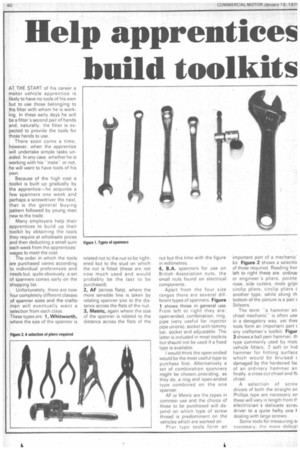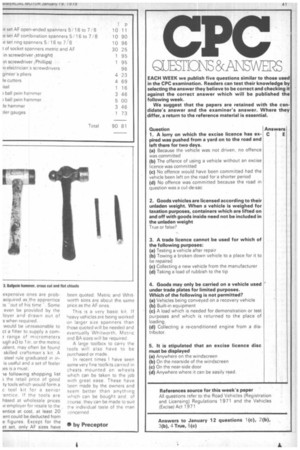Help apprentices build toolkits
Page 42

Page 43

If you've noticed an error in this article please click here to report it so we can fix it.
AT THE START of his career a motor vehicle apprentice is likely to have no tools of his own but to use those belonging to the fitter with whom he is working. In these early days he will be a fitter's second pair of hands and, naturally, the fitter is expected to provide the tools for those hands to use.
There soon come a time, however, when the apprentice will undertake simple tasks unaided. In any case, whether he is working with his "mateor not, he will want to have tools of his own.
Because of the high cost a toolkit is built up gradually by the apprentice—he acquires a few spanners one week and perhaps a screwdriver the next, that is the general buying pattern followed by young men new to the trade.
Many employers help their apprentices to build up their toolkit by obtaining the tools they require at wholesale prices and then deducting a small sum each week from the apprentices' wages to meet the cost.
The order in which the tools are purchased varies according to individual preferences and needs but, quite obviously, a set of spanners comes early on the shopping list.
Unfortunately, there are now four completely different classes of spanner sizes and the craftsman will eventually want a selection from each class.
These types are: 1, Whitworth, where the size of the spa nner is related not to the nut to be tightened but to the stud on which the nut is fitted (these are not now much used and would probably be the last to be purchased).
2, AF (across flats), where the more sensible line is taken by relating spanner size to the distance across the flats of the nut.
3, Metric, again where the size of the spanner is related to the distance across the flats of the nut but this time with the figure in millimetres.
8, B.A. spanners for use on British Association nuts, the small nuts found on electrical. components.
Apart from the four size ranges there are several different types of spanners. Figure 1 shows those in general use. From left to right they are: open-ended, combination, ring, pipe (very useful for injector pipe unions), socket with tommy bar, socket and adjustable. The latter is included in most toolkits but shciuld not be used if a fixed type is available.
I would think the open-ended would be the most useful type to purchase first. Alternatively a set of combination spanners might be chosen-providing, as they do, a ring and open-ended type combined on the one spanner.
AF or Metric are the ,types in common use and the choice of those to be purchased will depend on which type of screw thread is predominant on the vehicles which are worked on.
Plier type tools form an important part of a mechanic' kit. Figure 2 shows a selectio of those required. Reading fror left to right these are ordinat or engineer's pliers, pointe nose, side cutters, mole grip: circlip pliers,. circlip pliers c another type, while along th bottom of the picture is a pair c Stilsons.
The term -a hammer an chisel mechanicis often use in a derogatory way, yet thes tools form an important part c any craftsman's toolkit. Figur 3 shows a ball pein hammer, th type commonly used by motc vehicle fitters, 2 soft or hid hammer for hitting surface which would be bruised c damaged by the hardened fac of an ordinary hammer an finally, a cross cut chisel and fli chisel.
A selection of sues', drivers of both the straight an Phillips type are necessary an these will vary in length from th electrician's delicate sere driver to a quite hefty one f dealing with large screws.
Some tools for measuring ai necessary; the more delicai
expensive ones are probacquired as the apprentice ts "out of his time-. Some even be provided by the loyer and drawn out of s when required.
would be unreasonable to ct a fitter to supply a corn? range of micrometers 'ugh a Oto lin, or the metric valent. may often be found skilled craftsman's kit. A steel rule graduated in inis useful and a set of feeler ies is a must.
le following shopping list ; the retail price of good ty tools which would form a c tool kit for a senior .entice. If the tools are based at wholesale prices le employer for resale to the entice at cost, at least 20 :ent could be deducted from e figures. Except for the et set, only AF sizes have
been quoted, Metric and Whitworth sizes are about the same price as the AF ones.
This is a very basic kit, If heavy vehicles are being worked on larger size spanners than those quoted will be needed and eventually Whitworth, Metric and BA sizes will be required.
A large toolbox to carry the tools will also have to be purchased or made.
In recent times I have seen some very fine toolkits carried in chests mounted on wheels which can be taken to the iob with great ease. These have been made by the owners and seem better than anything which can be bought and. of course, they can be made to suit the individual taste of the man concerned tik by Preceptor




































































































